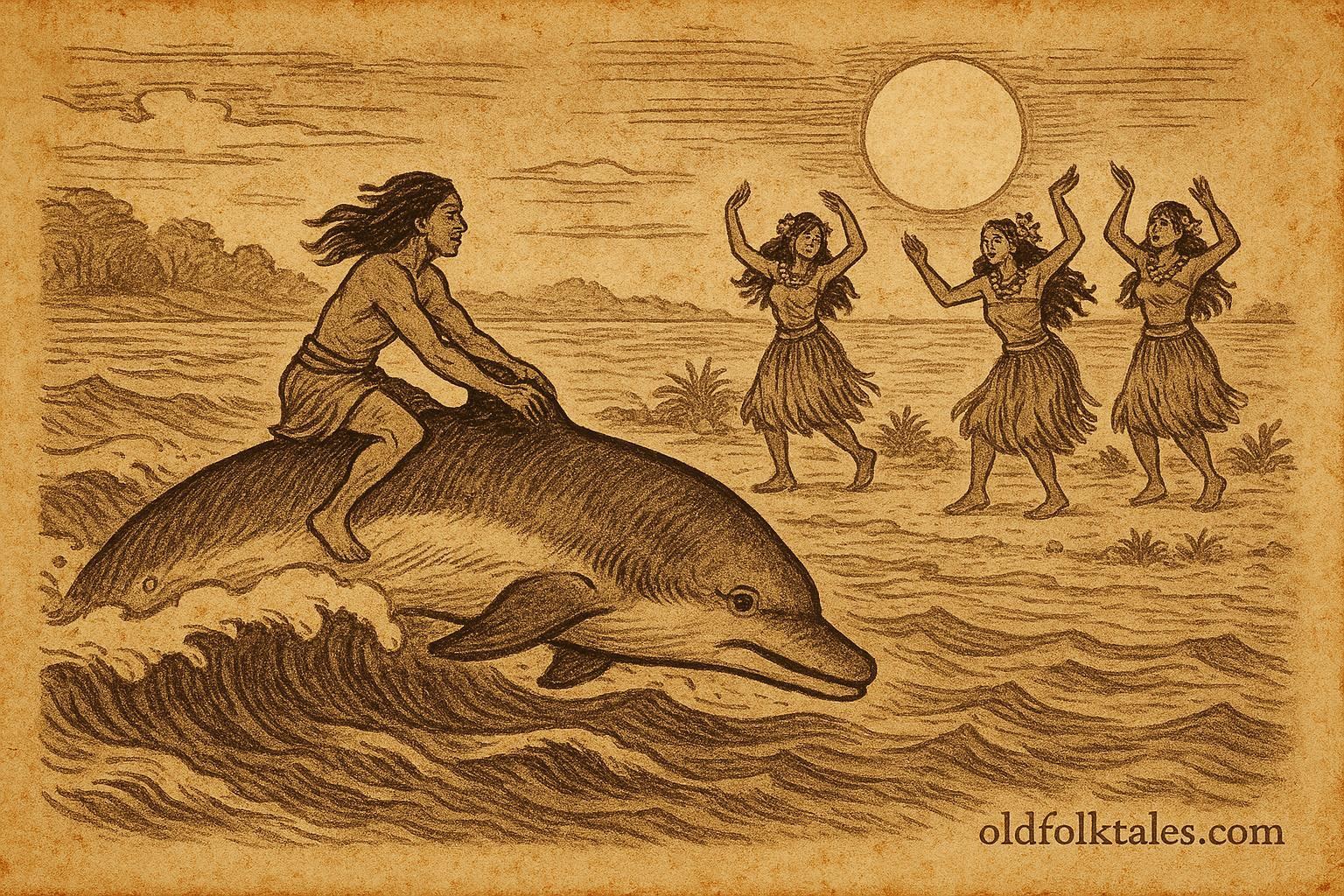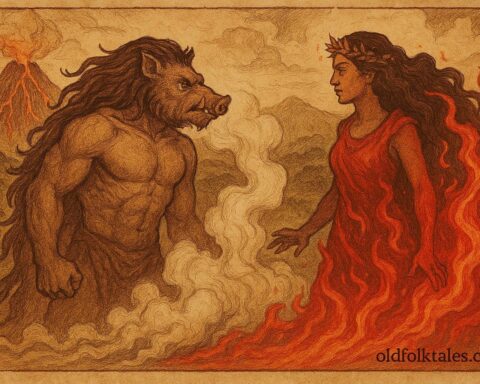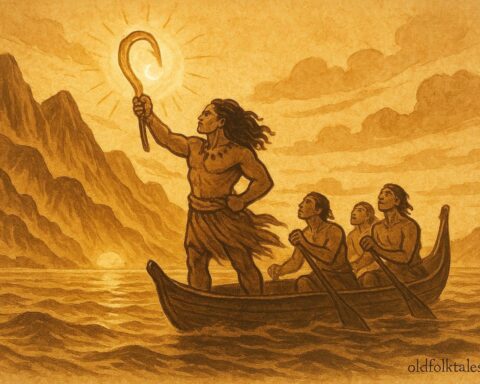In the ancient days of Aotearoa, when the world still shimmered with the breath of the gods and every creature held sacred purpose, there lived a great chief and guardian of the sea named Tinirau. He was known far and wide as the protector of the sacred dolphins, beings that could carry messages between the realms of Tangaroa, the god of the ocean, and humankind. Among these sea creatures was one he loved above all others, a dolphin named Tutunui.
Tutunui was no ordinary creature. His body gleamed like sunlight upon water, and his song echoed through the deep as a melody of both joy and warning. Between Tinirau and Tutunui existed a bond not only of affection but of spiritual kinship. They understood each other’s thoughts, a sacred connection that tied chief and creature as one.
The Visit of Kae
One season, Tinirau welcomed a man named Kae into his home. Kae was a learned priest, respected in his own right, and he came to perform sacred rituals and blessings for Tinirau’s household. As was the custom, he was treated with honor, given shelter, food, and hospitality. Tinirau trusted him, for the ties of ritual were binding and sacred in those times.
When Kae’s work was complete, he asked Tinirau for help in returning home. His village was far across the waters, and the journey by canoe was long and uncertain. Out of generosity, Tinirau offered him safe passage upon his sacred dolphin, Tutunui.
Before Kae mounted Tutunui’s back, Tinirau gave him strict instructions:
“When you reach the shallows near your home, my friend, you must release him. Do not force him closer to the shore, for the sea spirits guard his path. If you drive him too far inland, he will perish.”
Kae nodded solemnly, promising to obey. He climbed upon Tutunui’s back, and together, man and dolphin glided across the waters. The waves curled softly beneath them, and the sea breeze whispered around their journey. Tutunui carried Kae swiftly home, his sleek form cutting through the waves like a spirit of the ocean.
The Treachery of Kae
But when they neared the coast, greed and carelessness overtook Kae’s heart. Seeing that the dolphin carried him so easily, he decided to drive Tutunui all the way into the shallows before dismounting. The sacred dolphin, tired and disoriented from the breaking waves, became trapped.
Instead of helping Tutunui return to the sea, Kae turned his back. He summoned his people and said, “This creature is large and fat. Let us feast upon it!”
That night, the villagers slaughtered Tutunui and roasted his flesh over their fires. The smell of the sacred dolphin’s meat drifted far across the sea. Tinirau, sitting in his home, suddenly felt a deep pain in his heart. His spirit sensed the death of his companion. He rose in sorrow and anger, his eyes fierce with grief.
The next morning, as the wind shifted, the scent of roasted flesh reached his nostrils. He knew then that the unthinkable had happened. Kae had betrayed him, had killed and eaten Tutunui, his sacred friend.
The Gathering of the Women
Tinirau’s wrath burned like the rising sun. Yet vengeance, among the Māori, was not an act of rage but one of balance, to restore what had been broken. So he gathered his kin and devised a plan to bring Kae to justice.
He summoned a group of women renowned for their intelligence and artistry, led by Hine-te-iwaiwa, the guardian of women, weaving, and childbirth. Tinirau instructed them:
“You must go to Kae’s village and bring him back to me. But he is cunning, he will hide among his people. You must use wit, not force. Find him through laughter and song.”
The women prepared themselves for the journey. They adorned their hair with fragrant leaves, painted their faces with red ochre, and practiced the songs and dances that would draw all eyes to them. Their beauty and artistry would be their weapon.
They set out across the waves in the twilight hours, their canoe gliding silently over the dark waters. When dawn broke, they reached Kae’s village.
The Song of Deception
The women landed quietly and entered the settlement. They greeted the people with warmth and laughter, saying they had come to perform dances to entertain the village. The people welcomed them gladly, eager to see their performance.
As the women began to sing and dance, their movements were graceful, their voices weaving like the wind. They sang playful songs, songs that made the villagers laugh, songs that loosened tongues and lightened hearts.
But beneath their melody was a secret purpose, they had been told that Kae’s teeth were distinctive, crooked in a way that made him recognizable when he smiled.
So the women danced and jested, making the people laugh harder and harder. Each time they told a joke or performed a trick, they watched the crowd’s faces closely. Finally, one of their songs sent the whole village into laughter, and Kae, unable to resist, threw back his head and smiled broadly. The women saw the telltale teeth and knew they had found their man.
They hid their excitement and continued performing. When the night grew late and the villagers began to tire, they invited everyone to rest. But while others slept, they quietly bound Kae in soft ropes, covering him with mats so he could not cry out.
Before dawn, they carried him back to their canoe and set sail for Tinirau’s island. The sea shimmered around them, as though the spirit of Tutunui guided their journey home.
Justice Restored
When they arrived, Tinirau awaited them. He approached the bound man and looked upon him with heavy sorrow.
“Kae,” he said, “you have betrayed the sacred bond between guest and host. You have killed that which was under my protection, a creature of Tangaroa himself.”
Kae hung his head, unable to speak. The people gathered around, their faces filled with anger and grief. Justice had to be served, not out of vengeance alone, but to restore harmony between the realms of sea and land.
Tinirau ordered that Kae be punished in accordance with sacred law. When it was done, the sea grew calm again, as if appeased by the act. The spirit of Tutunui, the faithful dolphin, was said to have returned to the depths of Tangaroa’s domain, where his song could still be heard in the tides.
Moral Lesson
The story of Tinirau and Kae reminds us that every act of betrayal against nature and kin carries consequences. The sacred bond between humans and the natural world is not to be taken lightly. To respect what is entrusted to us, whether friendship, spirit, or the creatures of the earth, is to live in harmony. Betrayal, no matter how hidden, disturbs the balance and calls forth justice to restore it.
Knowledge Check (Q&A)
- Who was Tinirau in Māori mythology?
Tinirau was a guardian of the sea and keeper of sacred dolphins, revered as protectors of divine balance. - What was Tutunui’s role in the story?
Tutunui was Tinirau’s sacred dolphin, whose death by Kae’s betrayal led to divine retribution. - Why did Kae betray Tinirau?
Kae disobeyed sacred instruction and, driven by greed, killed and ate Tutunui after being safely carried home. - How did Tinirau avenge Tutunui’s death?
He sent women skilled in song and dance to capture Kae through deception and artistry. - What moral does this Māori legend teach?
It teaches respect for sacred bonds and the natural world,that wrongdoing disrupts cosmic harmony. - What cultural practice does the story highlight?
It highlights the Māori values of hospitality (manaakitanga), spiritual justice, and the sacred use of song and performance.
Source: Adapted from The Lore of the Whare-Wānanga by H.T. Whatahoro (trans. S. Percy Smith, 1913)
Cultural Origin: Māori (Aotearoa/New Zealand)












